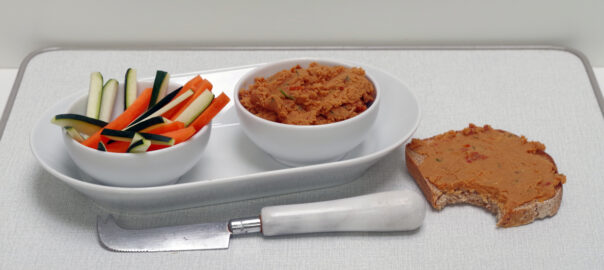Yoga Kitchen – Simple, healthy, and plant-based
Pulses with some extra punch
Chickpeas are perhaps the most popular type of pulses. They are widely eaten around the Mediterranean and in the Middle East. They form the basis of hummus, a creamy puree eaten as a dip or as a sandwich spread.
For classic hummus, cooked chickpeas are ground into a smooth mixture with sesame paste (tahini), olive oil, some spices, salt and lemon juice. But you don’t have to stick to that one classic recipe. The variations are endless.
Below is a simple recipe for tomato hummus. The dried tomato gives a deeper colour and also a bit more punch to the hummus. However, you could just as easily use other vegetables instead of tomato.
The ingredients for about 600g of tomato hummus
- 460 g jarred or canned chickpeas or 200 g dry chickpeas
- 45 g dried tomato or about 80 g dried tomato marinated in oil
- 2 tablespoons tahini
- 2 tablespoons of olive oil
- a teaspoon of garlic powder
- a teaspoon of curcuma
- a generous amount of black pepper
- optionally fresh green herbs such as coriander, parsley or chives
- maybe a few tablespoons of water to make the end result creamier
This is how to prepare the hummus
First method: starting from dry tomato and dry chickpeas
I personally prefer to work with dry chickpeas and dry tomatoes in bulk. This is much more economic in terms of price and avoids unnecessary packaging to be wasted.
Taste the dried tomato to estimate the salt content. Loose, dried tomatoes often already contain a good deal of salt. In that case, you can add the soaking water of the tomatoes to the hummus for which no extra salt is needed.
- Chop the dried tomatoes into pieces.
- Soak them overnight in about 150 ml of water. They will double in volume and weight.
- Keep the tomato pieces and their soaking water.
- Soak the chickpeas for 24 h in plenty of water. They also double in volume and weight.
- Drain and briefly rinse the chickpeas.
- Bring them to the boil in 3 to 4 times their volume of water, without salt.
- Scoop off the foam floating on top with a skimmer until the boiling water remains more or less clear.
- Then close the lid of the steamer pan.
- Cook them under pressure for about 35 minutes.
- Let the chickpeas cool.
- Put the chickpeas, the tomatoes with their soaking water and the other ingredients into a food processor with an S-shaped blade.
- Blend them into a creamy, orange puree. Add a little extra water if necessary.
- Divide the hummus over glass jars and store in the fridge.
If you don’t have a pressure cooker, you can also cook the chickpeas until tender in a conventional pan with a lid. Then count on a cooking time of one hour.
Second method: dried tomatoes in oil and pre-cooked canned chickpeas
You can also use dried, or rather semi-dried tomatoes from glass jars. These are dried tomatoes that are usually preserved in sometimes spicy oil and are therefore a bit more moist. Taste again for to estimate their salt content. You don’t need to pre-soak these marinated tomatoes first. Just drain them briefly.
Canned or jarred chickpeas, in liquid, are already pre-cooked. You don’t need the liquid from the packaging. You can cook them for an extra five to 10 minutes if necessary.
- Chop the tomatoes.
- Drain the liquid from the chickpeas.
- Cook the chickpeas in water for another 10 minutes if necessary.
- If so, leave the chickpeas to cool.
- Put the chickpeas, the tomatoes with their soaking water and the other ingredients into a food processor with an S-shaped blade.
- Blend them into a creamy, orange puree. Add a little extra water if necessary.
- Divide the hummus over glass jars and store in the fridge.
Done!
The hummus thus obtained will keep for up to 10 days in the fridge.
Are chickpeas full-fledged meat substitutes?
Chickpeas alone? The answer is no.
Cutting meat and other animal products from your menu and replacing them with legumes alone? Read below to find out what to consider.
Good legumes include:
- Beans of all shapes and colours
- Lentils in all possible shapes and colours
- Lupin seeds
- Soybeans and products derived from them such as tofu and tempeh
Soybeans and lupin seeds contain a pretty complete amino acid profile that is quite close to the amino acid profile of animal proteins.
In contrast, other beans and lentils are richer in the essential amino acid lysine, but contain little methionine. If you were to eat really only beans and lentils, it could potentially lead to imbalances.
Some examples of good grains, provided they are as complete (whole grain) as possible are :
- Wheat
- Rye
- Spelt
- Unicorn
- Oats
- Barley
- Rice
- Corn
- Millet
Good pseudo-grains are:
- Buckwheat
- Quinoa
- Amaranth
Within this group of grains and pseudo-grains, it is quinoa that has the most balanced and complete amino acid profile.
The cereals and pseudo-grains, with the exception of quinoa, actually have a good amount of methionine. However, their lysine content is low compared to animal protein. Right opposite to legumes!
So legumes and cereals complement each other perfectly. So does this recipe’s hummus make a good pair with wholemeal bread, for example.
What vegetable protein do I eat best?
Apply the following two golden rules:
- Eat soy and lupine products and/or quinoa liberally and regularly.
- Eat grains and pseudo-grains combined with legumes.
There’s no need to combine grains and pulses in one and the same meal.
Tomato hummus, approximately per 100g product
| Energy | Carboh. | Sugars | Fat | Sat. Fat | Protein | Fibre | Salt |
|---|---|---|---|---|---|---|---|
| 781 kJ/187 kcal | 21,3 g | 4,5 g | 8,9 g | 0,9 g | 7,2 g | 5,5 g | ? |
Participate in our cooking classes:
Read more about plant-based nutrition and health:
Read more about plant-based food
Find out about yoga and yoga classes in Schaerbeek:
Check out our yoga classes here:

